Trade Relations of Australia
VerifiedAdded on 2020/12/28
|14
|3889
|396
Report
AI Summary
This report examines Australia's trade relations with key countries like the US, UK, China, Korea, Indonesia, Japan, India, and Germany. It analyzes factors affecting trade, including inflation, national income, government policies, and import restrictions. The report highlights the strengths and challenges of Australia's trade partnerships and provides insights into areas for future development.
Contribute Materials
Your contribution can guide someone’s learning journey. Share your
documents today.
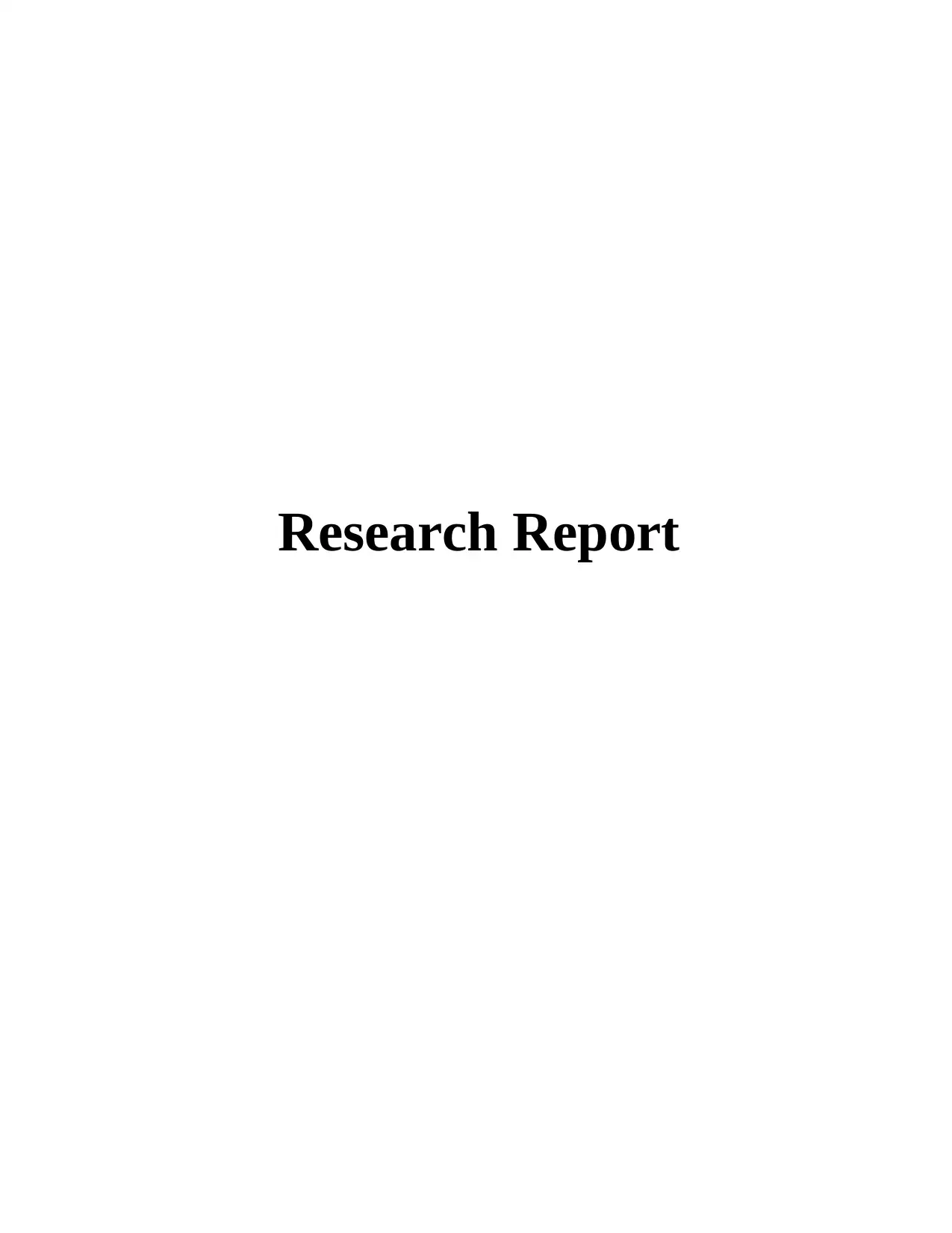
Research Report
Secure Best Marks with AI Grader
Need help grading? Try our AI Grader for instant feedback on your assignments.
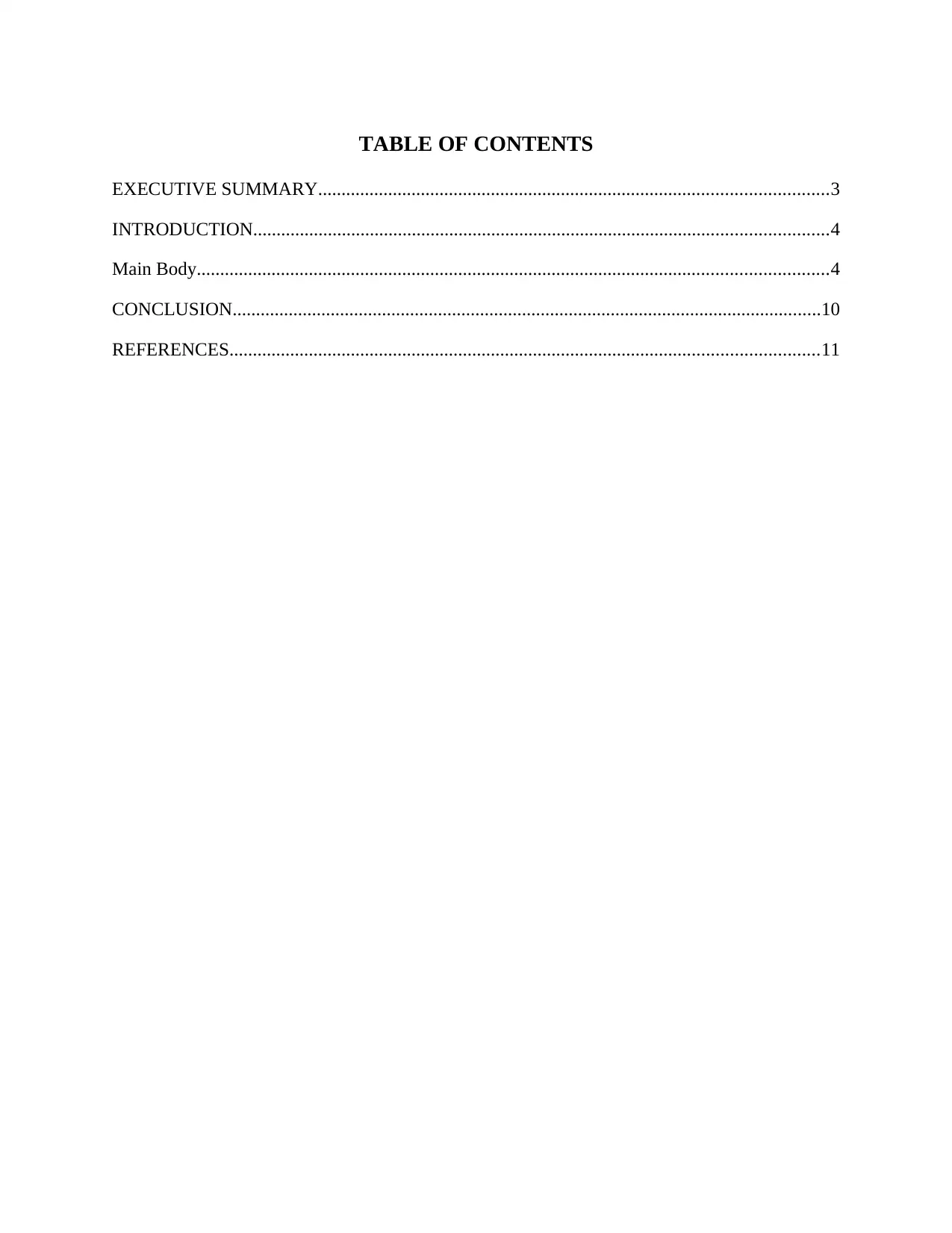
TABLE OF CONTENTS
EXECUTIVE SUMMARY.............................................................................................................3
INTRODUCTION...........................................................................................................................4
Main Body.......................................................................................................................................4
CONCLUSION..............................................................................................................................10
REFERENCES..............................................................................................................................11
EXECUTIVE SUMMARY.............................................................................................................3
INTRODUCTION...........................................................................................................................4
Main Body.......................................................................................................................................4
CONCLUSION..............................................................................................................................10
REFERENCES..............................................................................................................................11
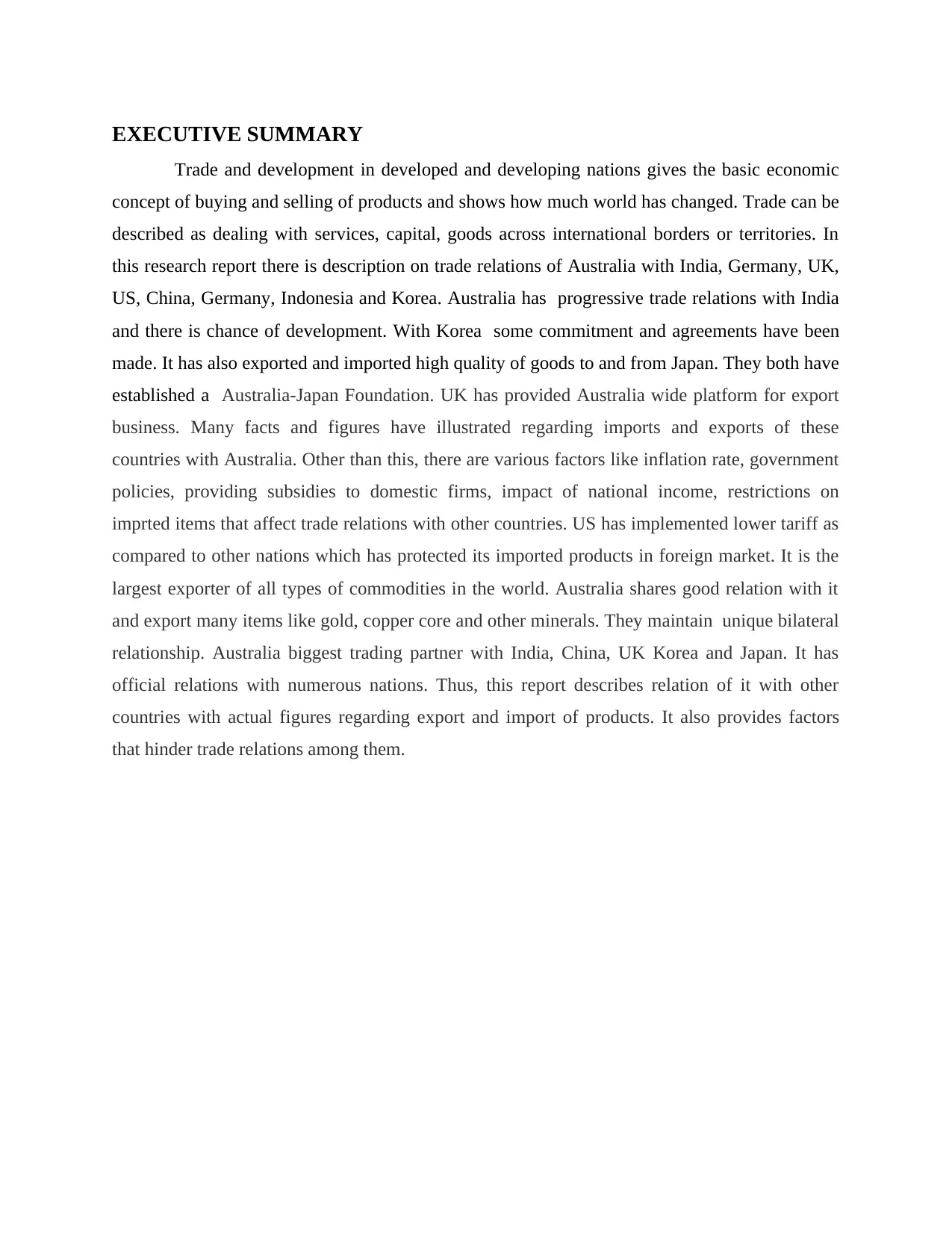
EXECUTIVE SUMMARY
Trade and development in developed and developing nations gives the basic economic
concept of buying and selling of products and shows how much world has changed. Trade can be
described as dealing with services, capital, goods across international borders or territories. In
this research report there is description on trade relations of Australia with India, Germany, UK,
US, China, Germany, Indonesia and Korea. Australia has progressive trade relations with India
and there is chance of development. With Korea some commitment and agreements have been
made. It has also exported and imported high quality of goods to and from Japan. They both have
established a Australia-Japan Foundation. UK has provided Australia wide platform for export
business. Many facts and figures have illustrated regarding imports and exports of these
countries with Australia. Other than this, there are various factors like inflation rate, government
policies, providing subsidies to domestic firms, impact of national income, restrictions on
imprted items that affect trade relations with other countries. US has implemented lower tariff as
compared to other nations which has protected its imported products in foreign market. It is the
largest exporter of all types of commodities in the world. Australia shares good relation with it
and export many items like gold, copper core and other minerals. They maintain unique bilateral
relationship. Australia biggest trading partner with India, China, UK Korea and Japan. It has
official relations with numerous nations. Thus, this report describes relation of it with other
countries with actual figures regarding export and import of products. It also provides factors
that hinder trade relations among them.
Trade and development in developed and developing nations gives the basic economic
concept of buying and selling of products and shows how much world has changed. Trade can be
described as dealing with services, capital, goods across international borders or territories. In
this research report there is description on trade relations of Australia with India, Germany, UK,
US, China, Germany, Indonesia and Korea. Australia has progressive trade relations with India
and there is chance of development. With Korea some commitment and agreements have been
made. It has also exported and imported high quality of goods to and from Japan. They both have
established a Australia-Japan Foundation. UK has provided Australia wide platform for export
business. Many facts and figures have illustrated regarding imports and exports of these
countries with Australia. Other than this, there are various factors like inflation rate, government
policies, providing subsidies to domestic firms, impact of national income, restrictions on
imprted items that affect trade relations with other countries. US has implemented lower tariff as
compared to other nations which has protected its imported products in foreign market. It is the
largest exporter of all types of commodities in the world. Australia shares good relation with it
and export many items like gold, copper core and other minerals. They maintain unique bilateral
relationship. Australia biggest trading partner with India, China, UK Korea and Japan. It has
official relations with numerous nations. Thus, this report describes relation of it with other
countries with actual figures regarding export and import of products. It also provides factors
that hinder trade relations among them.
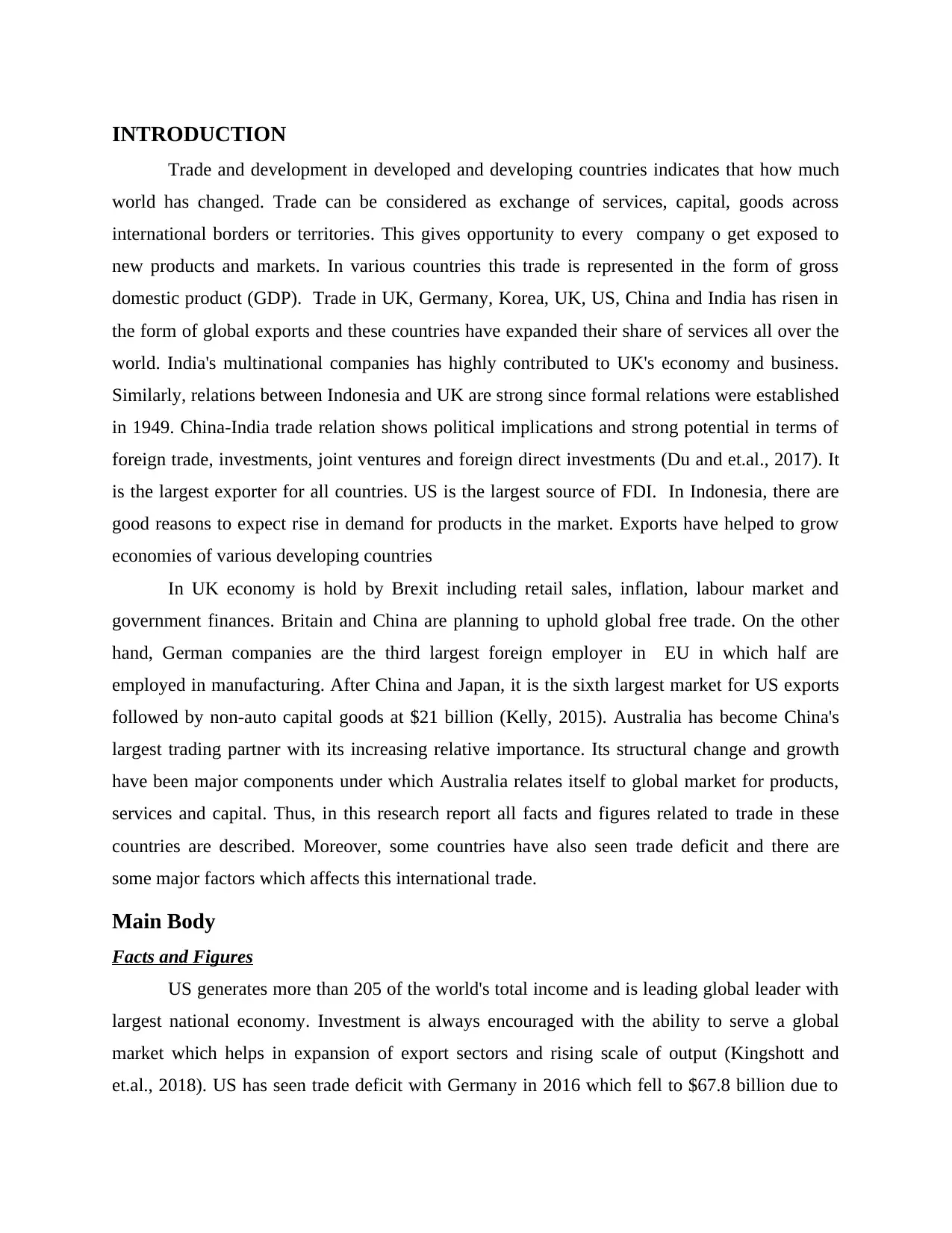
INTRODUCTION
Trade and development in developed and developing countries indicates that how much
world has changed. Trade can be considered as exchange of services, capital, goods across
international borders or territories. This gives opportunity to every company o get exposed to
new products and markets. In various countries this trade is represented in the form of gross
domestic product (GDP). Trade in UK, Germany, Korea, UK, US, China and India has risen in
the form of global exports and these countries have expanded their share of services all over the
world. India's multinational companies has highly contributed to UK's economy and business.
Similarly, relations between Indonesia and UK are strong since formal relations were established
in 1949. China-India trade relation shows political implications and strong potential in terms of
foreign trade, investments, joint ventures and foreign direct investments (Du and et.al., 2017). It
is the largest exporter for all countries. US is the largest source of FDI. In Indonesia, there are
good reasons to expect rise in demand for products in the market. Exports have helped to grow
economies of various developing countries
In UK economy is hold by Brexit including retail sales, inflation, labour market and
government finances. Britain and China are planning to uphold global free trade. On the other
hand, German companies are the third largest foreign employer in EU in which half are
employed in manufacturing. After China and Japan, it is the sixth largest market for US exports
followed by non-auto capital goods at $21 billion (Kelly, 2015). Australia has become China's
largest trading partner with its increasing relative importance. Its structural change and growth
have been major components under which Australia relates itself to global market for products,
services and capital. Thus, in this research report all facts and figures related to trade in these
countries are described. Moreover, some countries have also seen trade deficit and there are
some major factors which affects this international trade.
Main Body
Facts and Figures
US generates more than 205 of the world's total income and is leading global leader with
largest national economy. Investment is always encouraged with the ability to serve a global
market which helps in expansion of export sectors and rising scale of output (Kingshott and
et.al., 2018). US has seen trade deficit with Germany in 2016 which fell to $67.8 billion due to
Trade and development in developed and developing countries indicates that how much
world has changed. Trade can be considered as exchange of services, capital, goods across
international borders or territories. This gives opportunity to every company o get exposed to
new products and markets. In various countries this trade is represented in the form of gross
domestic product (GDP). Trade in UK, Germany, Korea, UK, US, China and India has risen in
the form of global exports and these countries have expanded their share of services all over the
world. India's multinational companies has highly contributed to UK's economy and business.
Similarly, relations between Indonesia and UK are strong since formal relations were established
in 1949. China-India trade relation shows political implications and strong potential in terms of
foreign trade, investments, joint ventures and foreign direct investments (Du and et.al., 2017). It
is the largest exporter for all countries. US is the largest source of FDI. In Indonesia, there are
good reasons to expect rise in demand for products in the market. Exports have helped to grow
economies of various developing countries
In UK economy is hold by Brexit including retail sales, inflation, labour market and
government finances. Britain and China are planning to uphold global free trade. On the other
hand, German companies are the third largest foreign employer in EU in which half are
employed in manufacturing. After China and Japan, it is the sixth largest market for US exports
followed by non-auto capital goods at $21 billion (Kelly, 2015). Australia has become China's
largest trading partner with its increasing relative importance. Its structural change and growth
have been major components under which Australia relates itself to global market for products,
services and capital. Thus, in this research report all facts and figures related to trade in these
countries are described. Moreover, some countries have also seen trade deficit and there are
some major factors which affects this international trade.
Main Body
Facts and Figures
US generates more than 205 of the world's total income and is leading global leader with
largest national economy. Investment is always encouraged with the ability to serve a global
market which helps in expansion of export sectors and rising scale of output (Kingshott and
et.al., 2018). US has seen trade deficit with Germany in 2016 which fell to $67.8 billion due to
Secure Best Marks with AI Grader
Need help grading? Try our AI Grader for instant feedback on your assignments.
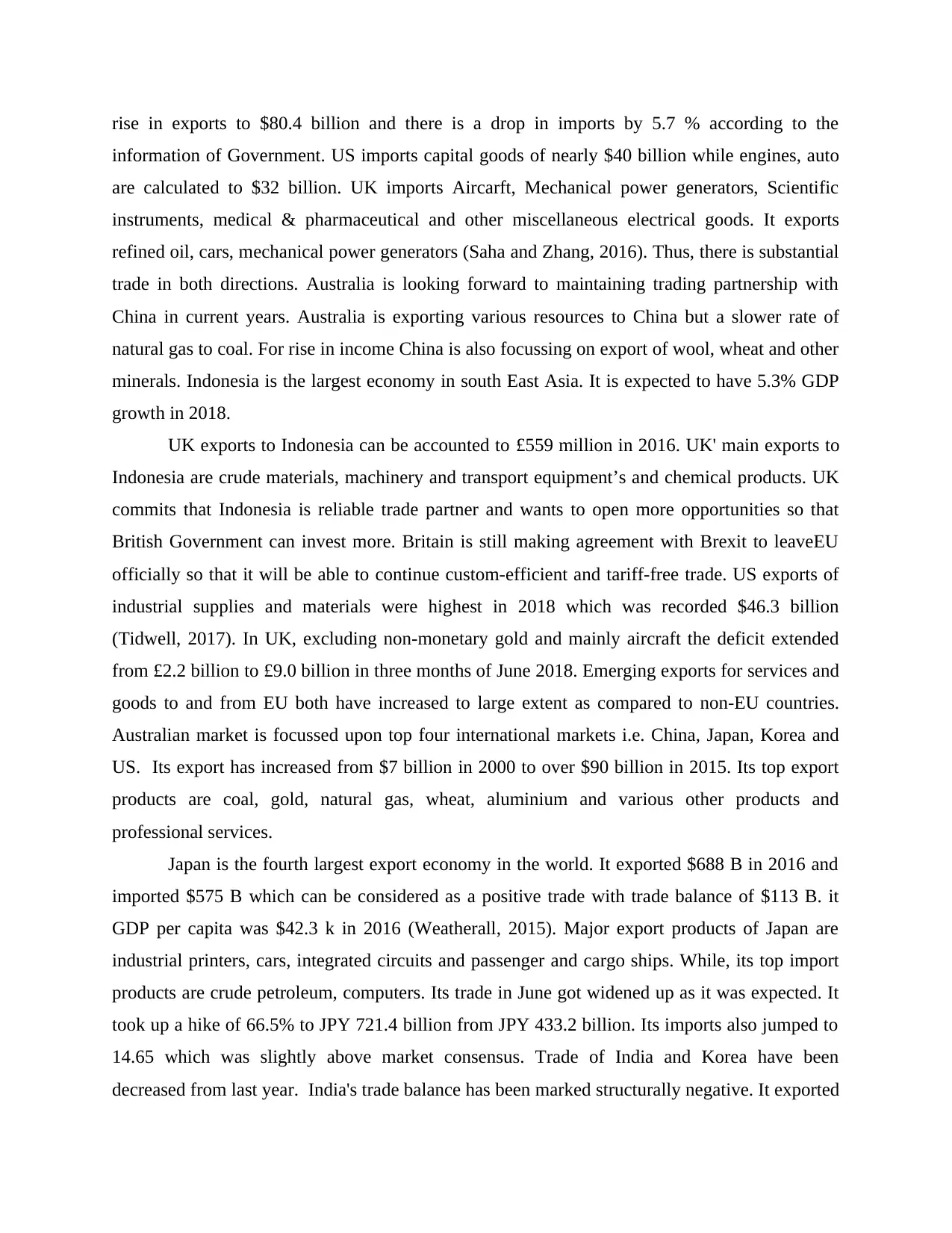
rise in exports to $80.4 billion and there is a drop in imports by 5.7 % according to the
information of Government. US imports capital goods of nearly $40 billion while engines, auto
are calculated to $32 billion. UK imports Aircarft, Mechanical power generators, Scientific
instruments, medical & pharmaceutical and other miscellaneous electrical goods. It exports
refined oil, cars, mechanical power generators (Saha and Zhang, 2016). Thus, there is substantial
trade in both directions. Australia is looking forward to maintaining trading partnership with
China in current years. Australia is exporting various resources to China but a slower rate of
natural gas to coal. For rise in income China is also focussing on export of wool, wheat and other
minerals. Indonesia is the largest economy in south East Asia. It is expected to have 5.3% GDP
growth in 2018.
UK exports to Indonesia can be accounted to £559 million in 2016. UK' main exports to
Indonesia are crude materials, machinery and transport equipment’s and chemical products. UK
commits that Indonesia is reliable trade partner and wants to open more opportunities so that
British Government can invest more. Britain is still making agreement with Brexit to leaveEU
officially so that it will be able to continue custom-efficient and tariff-free trade. US exports of
industrial supplies and materials were highest in 2018 which was recorded $46.3 billion
(Tidwell, 2017). In UK, excluding non-monetary gold and mainly aircraft the deficit extended
from £2.2 billion to £9.0 billion in three months of June 2018. Emerging exports for services and
goods to and from EU both have increased to large extent as compared to non-EU countries.
Australian market is focussed upon top four international markets i.e. China, Japan, Korea and
US. Its export has increased from $7 billion in 2000 to over $90 billion in 2015. Its top export
products are coal, gold, natural gas, wheat, aluminium and various other products and
professional services.
Japan is the fourth largest export economy in the world. It exported $688 B in 2016 and
imported $575 B which can be considered as a positive trade with trade balance of $113 B. it
GDP per capita was $42.3 k in 2016 (Weatherall, 2015). Major export products of Japan are
industrial printers, cars, integrated circuits and passenger and cargo ships. While, its top import
products are crude petroleum, computers. Its trade in June got widened up as it was expected. It
took up a hike of 66.5% to JPY 721.4 billion from JPY 433.2 billion. Its imports also jumped to
14.65 which was slightly above market consensus. Trade of India and Korea have been
decreased from last year. India's trade balance has been marked structurally negative. It exported
information of Government. US imports capital goods of nearly $40 billion while engines, auto
are calculated to $32 billion. UK imports Aircarft, Mechanical power generators, Scientific
instruments, medical & pharmaceutical and other miscellaneous electrical goods. It exports
refined oil, cars, mechanical power generators (Saha and Zhang, 2016). Thus, there is substantial
trade in both directions. Australia is looking forward to maintaining trading partnership with
China in current years. Australia is exporting various resources to China but a slower rate of
natural gas to coal. For rise in income China is also focussing on export of wool, wheat and other
minerals. Indonesia is the largest economy in south East Asia. It is expected to have 5.3% GDP
growth in 2018.
UK exports to Indonesia can be accounted to £559 million in 2016. UK' main exports to
Indonesia are crude materials, machinery and transport equipment’s and chemical products. UK
commits that Indonesia is reliable trade partner and wants to open more opportunities so that
British Government can invest more. Britain is still making agreement with Brexit to leaveEU
officially so that it will be able to continue custom-efficient and tariff-free trade. US exports of
industrial supplies and materials were highest in 2018 which was recorded $46.3 billion
(Tidwell, 2017). In UK, excluding non-monetary gold and mainly aircraft the deficit extended
from £2.2 billion to £9.0 billion in three months of June 2018. Emerging exports for services and
goods to and from EU both have increased to large extent as compared to non-EU countries.
Australian market is focussed upon top four international markets i.e. China, Japan, Korea and
US. Its export has increased from $7 billion in 2000 to over $90 billion in 2015. Its top export
products are coal, gold, natural gas, wheat, aluminium and various other products and
professional services.
Japan is the fourth largest export economy in the world. It exported $688 B in 2016 and
imported $575 B which can be considered as a positive trade with trade balance of $113 B. it
GDP per capita was $42.3 k in 2016 (Weatherall, 2015). Major export products of Japan are
industrial printers, cars, integrated circuits and passenger and cargo ships. While, its top import
products are crude petroleum, computers. Its trade in June got widened up as it was expected. It
took up a hike of 66.5% to JPY 721.4 billion from JPY 433.2 billion. Its imports also jumped to
14.65 which was slightly above market consensus. Trade of India and Korea have been
decreased from last year. India's trade balance has been marked structurally negative. It exported
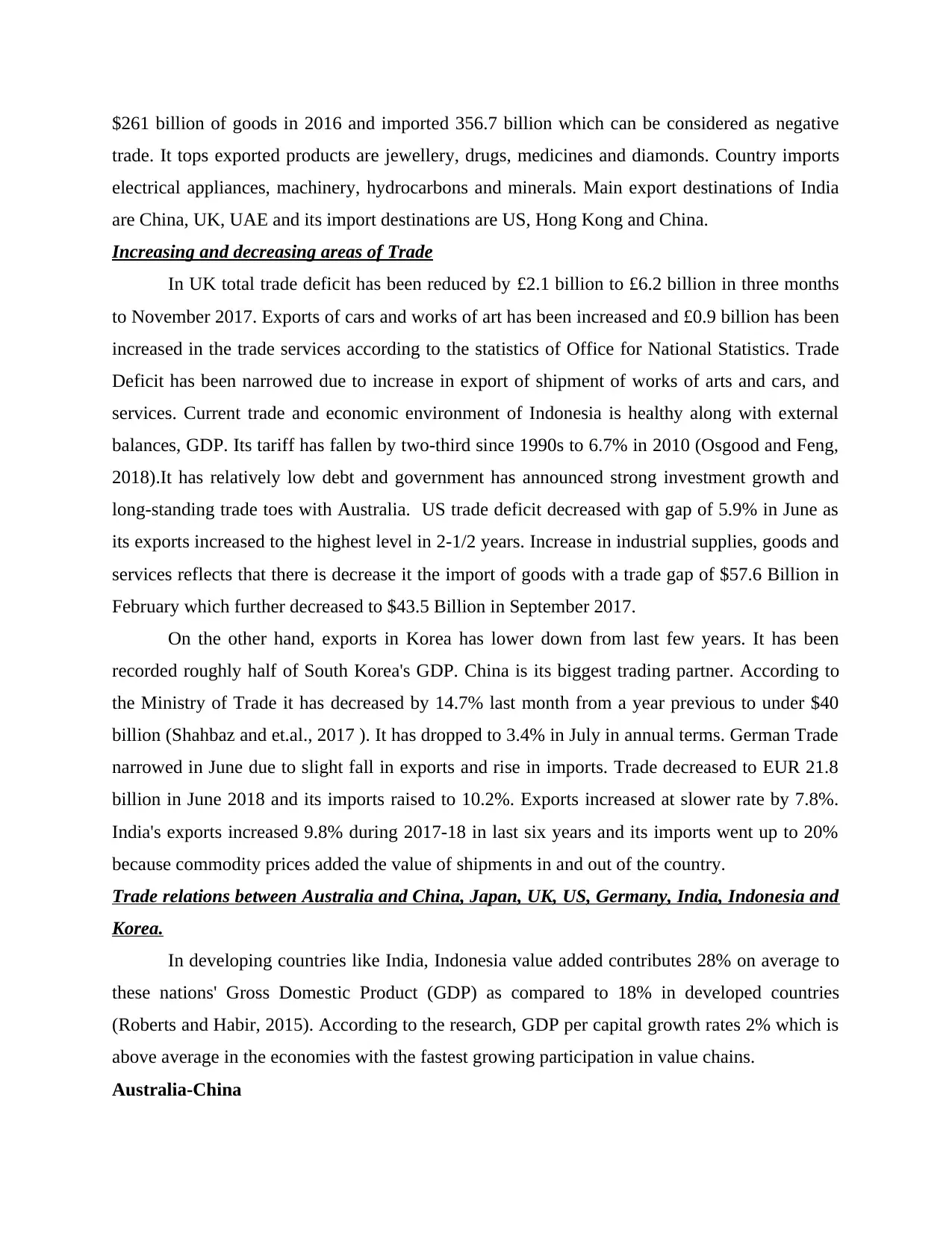
$261 billion of goods in 2016 and imported 356.7 billion which can be considered as negative
trade. It tops exported products are jewellery, drugs, medicines and diamonds. Country imports
electrical appliances, machinery, hydrocarbons and minerals. Main export destinations of India
are China, UK, UAE and its import destinations are US, Hong Kong and China.
Increasing and decreasing areas of Trade
In UK total trade deficit has been reduced by £2.1 billion to £6.2 billion in three months
to November 2017. Exports of cars and works of art has been increased and £0.9 billion has been
increased in the trade services according to the statistics of Office for National Statistics. Trade
Deficit has been narrowed due to increase in export of shipment of works of arts and cars, and
services. Current trade and economic environment of Indonesia is healthy along with external
balances, GDP. Its tariff has fallen by two-third since 1990s to 6.7% in 2010 (Osgood and Feng,
2018).It has relatively low debt and government has announced strong investment growth and
long-standing trade toes with Australia. US trade deficit decreased with gap of 5.9% in June as
its exports increased to the highest level in 2-1/2 years. Increase in industrial supplies, goods and
services reflects that there is decrease it the import of goods with a trade gap of $57.6 Billion in
February which further decreased to $43.5 Billion in September 2017.
On the other hand, exports in Korea has lower down from last few years. It has been
recorded roughly half of South Korea's GDP. China is its biggest trading partner. According to
the Ministry of Trade it has decreased by 14.7% last month from a year previous to under $40
billion (Shahbaz and et.al., 2017 ). It has dropped to 3.4% in July in annual terms. German Trade
narrowed in June due to slight fall in exports and rise in imports. Trade decreased to EUR 21.8
billion in June 2018 and its imports raised to 10.2%. Exports increased at slower rate by 7.8%.
India's exports increased 9.8% during 2017-18 in last six years and its imports went up to 20%
because commodity prices added the value of shipments in and out of the country.
Trade relations between Australia and China, Japan, UK, US, Germany, India, Indonesia and
Korea.
In developing countries like India, Indonesia value added contributes 28% on average to
these nations' Gross Domestic Product (GDP) as compared to 18% in developed countries
(Roberts and Habir, 2015). According to the research, GDP per capital growth rates 2% which is
above average in the economies with the fastest growing participation in value chains.
Australia-China
trade. It tops exported products are jewellery, drugs, medicines and diamonds. Country imports
electrical appliances, machinery, hydrocarbons and minerals. Main export destinations of India
are China, UK, UAE and its import destinations are US, Hong Kong and China.
Increasing and decreasing areas of Trade
In UK total trade deficit has been reduced by £2.1 billion to £6.2 billion in three months
to November 2017. Exports of cars and works of art has been increased and £0.9 billion has been
increased in the trade services according to the statistics of Office for National Statistics. Trade
Deficit has been narrowed due to increase in export of shipment of works of arts and cars, and
services. Current trade and economic environment of Indonesia is healthy along with external
balances, GDP. Its tariff has fallen by two-third since 1990s to 6.7% in 2010 (Osgood and Feng,
2018).It has relatively low debt and government has announced strong investment growth and
long-standing trade toes with Australia. US trade deficit decreased with gap of 5.9% in June as
its exports increased to the highest level in 2-1/2 years. Increase in industrial supplies, goods and
services reflects that there is decrease it the import of goods with a trade gap of $57.6 Billion in
February which further decreased to $43.5 Billion in September 2017.
On the other hand, exports in Korea has lower down from last few years. It has been
recorded roughly half of South Korea's GDP. China is its biggest trading partner. According to
the Ministry of Trade it has decreased by 14.7% last month from a year previous to under $40
billion (Shahbaz and et.al., 2017 ). It has dropped to 3.4% in July in annual terms. German Trade
narrowed in June due to slight fall in exports and rise in imports. Trade decreased to EUR 21.8
billion in June 2018 and its imports raised to 10.2%. Exports increased at slower rate by 7.8%.
India's exports increased 9.8% during 2017-18 in last six years and its imports went up to 20%
because commodity prices added the value of shipments in and out of the country.
Trade relations between Australia and China, Japan, UK, US, Germany, India, Indonesia and
Korea.
In developing countries like India, Indonesia value added contributes 28% on average to
these nations' Gross Domestic Product (GDP) as compared to 18% in developed countries
(Roberts and Habir, 2015). According to the research, GDP per capital growth rates 2% which is
above average in the economies with the fastest growing participation in value chains.
Australia-China
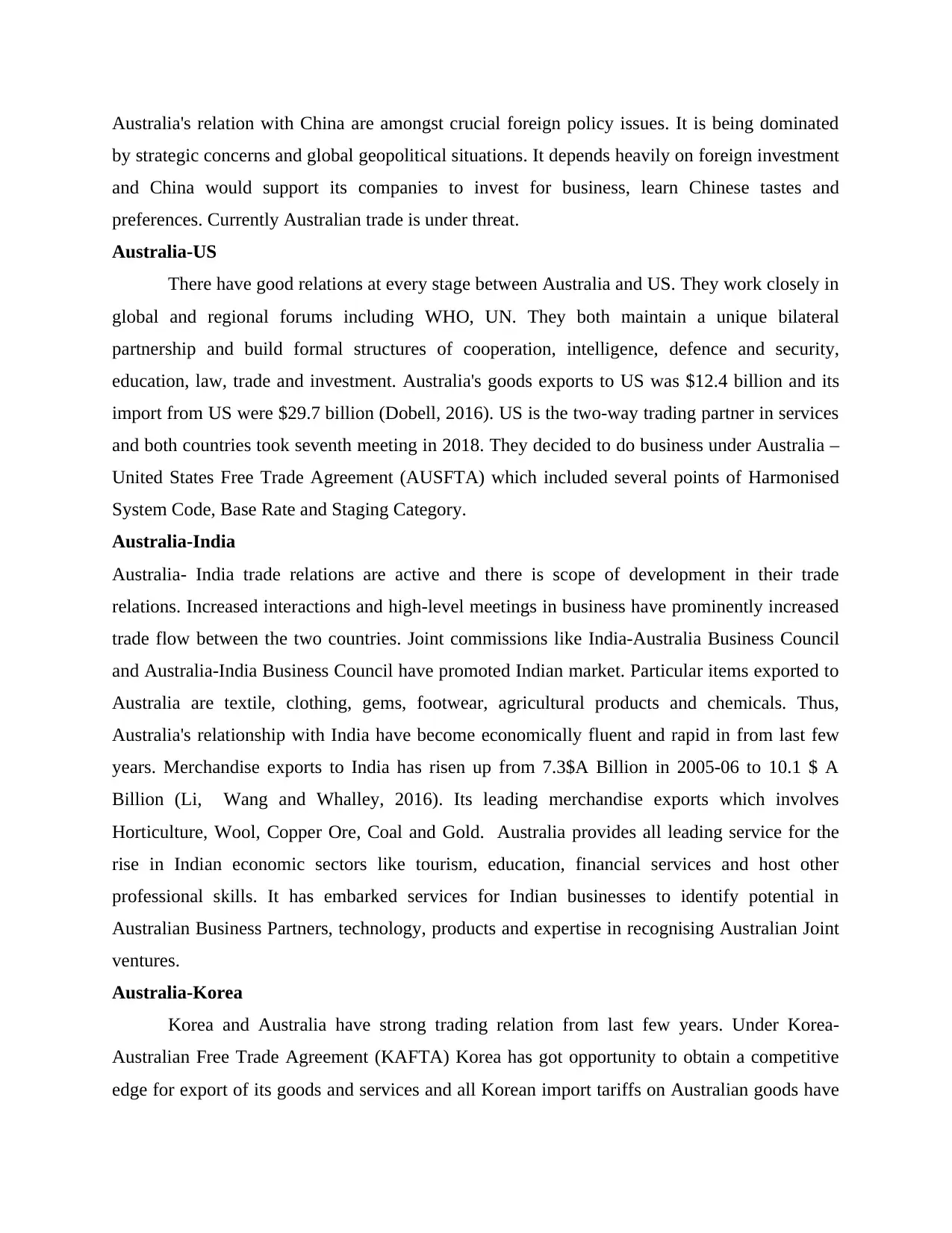
Australia's relation with China are amongst crucial foreign policy issues. It is being dominated
by strategic concerns and global geopolitical situations. It depends heavily on foreign investment
and China would support its companies to invest for business, learn Chinese tastes and
preferences. Currently Australian trade is under threat.
Australia-US
There have good relations at every stage between Australia and US. They work closely in
global and regional forums including WHO, UN. They both maintain a unique bilateral
partnership and build formal structures of cooperation, intelligence, defence and security,
education, law, trade and investment. Australia's goods exports to US was $12.4 billion and its
import from US were $29.7 billion (Dobell, 2016). US is the two-way trading partner in services
and both countries took seventh meeting in 2018. They decided to do business under Australia –
United States Free Trade Agreement (AUSFTA) which included several points of Harmonised
System Code, Base Rate and Staging Category.
Australia-India
Australia- India trade relations are active and there is scope of development in their trade
relations. Increased interactions and high-level meetings in business have prominently increased
trade flow between the two countries. Joint commissions like India-Australia Business Council
and Australia-India Business Council have promoted Indian market. Particular items exported to
Australia are textile, clothing, gems, footwear, agricultural products and chemicals. Thus,
Australia's relationship with India have become economically fluent and rapid in from last few
years. Merchandise exports to India has risen up from 7.3$A Billion in 2005-06 to 10.1 $ A
Billion (Li, Wang and Whalley, 2016). Its leading merchandise exports which involves
Horticulture, Wool, Copper Ore, Coal and Gold. Australia provides all leading service for the
rise in Indian economic sectors like tourism, education, financial services and host other
professional skills. It has embarked services for Indian businesses to identify potential in
Australian Business Partners, technology, products and expertise in recognising Australian Joint
ventures.
Australia-Korea
Korea and Australia have strong trading relation from last few years. Under Korea-
Australian Free Trade Agreement (KAFTA) Korea has got opportunity to obtain a competitive
edge for export of its goods and services and all Korean import tariffs on Australian goods have
by strategic concerns and global geopolitical situations. It depends heavily on foreign investment
and China would support its companies to invest for business, learn Chinese tastes and
preferences. Currently Australian trade is under threat.
Australia-US
There have good relations at every stage between Australia and US. They work closely in
global and regional forums including WHO, UN. They both maintain a unique bilateral
partnership and build formal structures of cooperation, intelligence, defence and security,
education, law, trade and investment. Australia's goods exports to US was $12.4 billion and its
import from US were $29.7 billion (Dobell, 2016). US is the two-way trading partner in services
and both countries took seventh meeting in 2018. They decided to do business under Australia –
United States Free Trade Agreement (AUSFTA) which included several points of Harmonised
System Code, Base Rate and Staging Category.
Australia-India
Australia- India trade relations are active and there is scope of development in their trade
relations. Increased interactions and high-level meetings in business have prominently increased
trade flow between the two countries. Joint commissions like India-Australia Business Council
and Australia-India Business Council have promoted Indian market. Particular items exported to
Australia are textile, clothing, gems, footwear, agricultural products and chemicals. Thus,
Australia's relationship with India have become economically fluent and rapid in from last few
years. Merchandise exports to India has risen up from 7.3$A Billion in 2005-06 to 10.1 $ A
Billion (Li, Wang and Whalley, 2016). Its leading merchandise exports which involves
Horticulture, Wool, Copper Ore, Coal and Gold. Australia provides all leading service for the
rise in Indian economic sectors like tourism, education, financial services and host other
professional skills. It has embarked services for Indian businesses to identify potential in
Australian Business Partners, technology, products and expertise in recognising Australian Joint
ventures.
Australia-Korea
Korea and Australia have strong trading relation from last few years. Under Korea-
Australian Free Trade Agreement (KAFTA) Korea has got opportunity to obtain a competitive
edge for export of its goods and services and all Korean import tariffs on Australian goods have
Paraphrase This Document
Need a fresh take? Get an instant paraphrase of this document with our AI Paraphraser
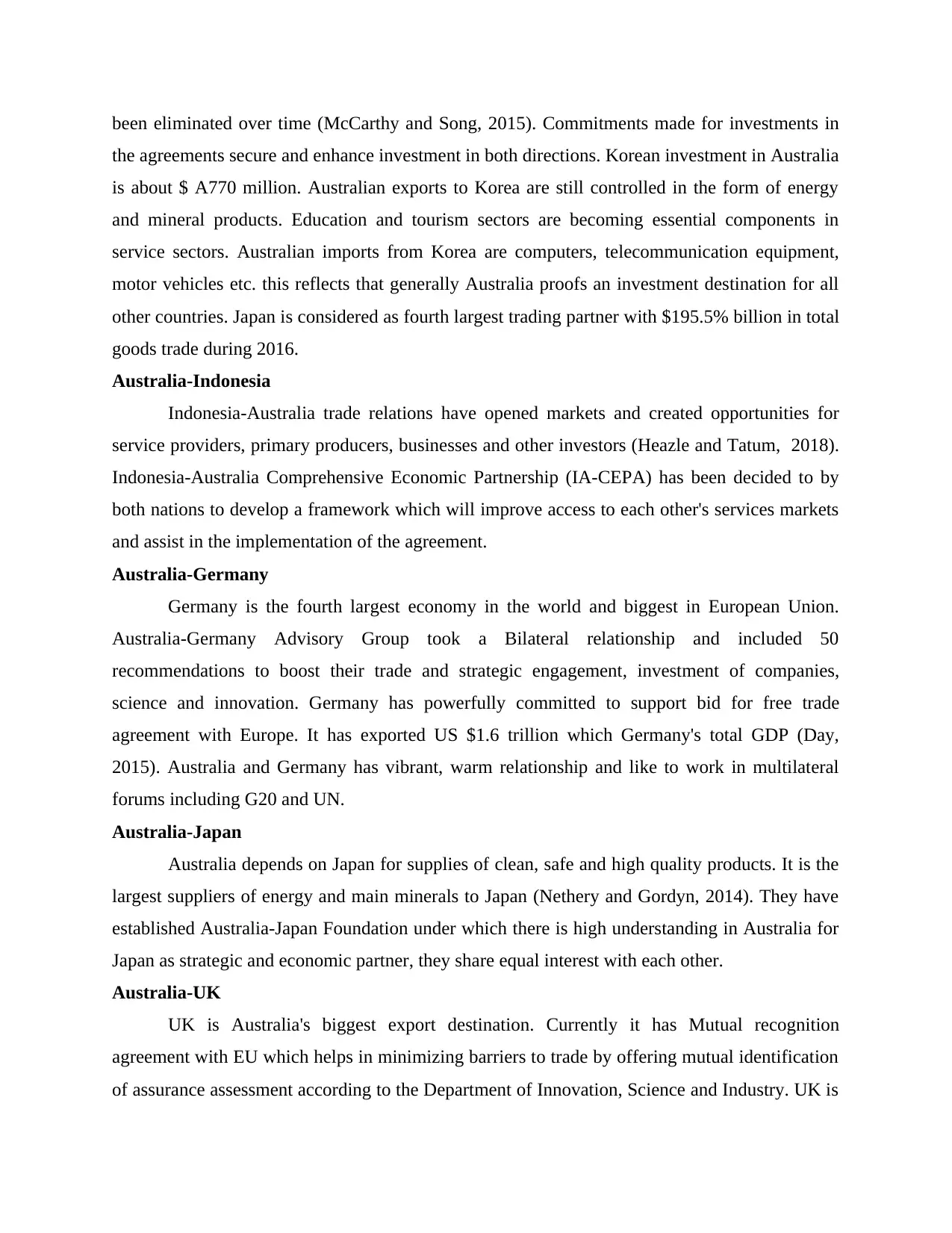
been eliminated over time (McCarthy and Song, 2015). Commitments made for investments in
the agreements secure and enhance investment in both directions. Korean investment in Australia
is about $ A770 million. Australian exports to Korea are still controlled in the form of energy
and mineral products. Education and tourism sectors are becoming essential components in
service sectors. Australian imports from Korea are computers, telecommunication equipment,
motor vehicles etc. this reflects that generally Australia proofs an investment destination for all
other countries. Japan is considered as fourth largest trading partner with $195.5% billion in total
goods trade during 2016.
Australia-Indonesia
Indonesia-Australia trade relations have opened markets and created opportunities for
service providers, primary producers, businesses and other investors (Heazle and Tatum, 2018).
Indonesia-Australia Comprehensive Economic Partnership (IA-CEPA) has been decided to by
both nations to develop a framework which will improve access to each other's services markets
and assist in the implementation of the agreement.
Australia-Germany
Germany is the fourth largest economy in the world and biggest in European Union.
Australia-Germany Advisory Group took a Bilateral relationship and included 50
recommendations to boost their trade and strategic engagement, investment of companies,
science and innovation. Germany has powerfully committed to support bid for free trade
agreement with Europe. It has exported US $1.6 trillion which Germany's total GDP (Day,
2015). Australia and Germany has vibrant, warm relationship and like to work in multilateral
forums including G20 and UN.
Australia-Japan
Australia depends on Japan for supplies of clean, safe and high quality products. It is the
largest suppliers of energy and main minerals to Japan (Nethery and Gordyn, 2014). They have
established Australia-Japan Foundation under which there is high understanding in Australia for
Japan as strategic and economic partner, they share equal interest with each other.
Australia-UK
UK is Australia's biggest export destination. Currently it has Mutual recognition
agreement with EU which helps in minimizing barriers to trade by offering mutual identification
of assurance assessment according to the Department of Innovation, Science and Industry. UK is
the agreements secure and enhance investment in both directions. Korean investment in Australia
is about $ A770 million. Australian exports to Korea are still controlled in the form of energy
and mineral products. Education and tourism sectors are becoming essential components in
service sectors. Australian imports from Korea are computers, telecommunication equipment,
motor vehicles etc. this reflects that generally Australia proofs an investment destination for all
other countries. Japan is considered as fourth largest trading partner with $195.5% billion in total
goods trade during 2016.
Australia-Indonesia
Indonesia-Australia trade relations have opened markets and created opportunities for
service providers, primary producers, businesses and other investors (Heazle and Tatum, 2018).
Indonesia-Australia Comprehensive Economic Partnership (IA-CEPA) has been decided to by
both nations to develop a framework which will improve access to each other's services markets
and assist in the implementation of the agreement.
Australia-Germany
Germany is the fourth largest economy in the world and biggest in European Union.
Australia-Germany Advisory Group took a Bilateral relationship and included 50
recommendations to boost their trade and strategic engagement, investment of companies,
science and innovation. Germany has powerfully committed to support bid for free trade
agreement with Europe. It has exported US $1.6 trillion which Germany's total GDP (Day,
2015). Australia and Germany has vibrant, warm relationship and like to work in multilateral
forums including G20 and UN.
Australia-Japan
Australia depends on Japan for supplies of clean, safe and high quality products. It is the
largest suppliers of energy and main minerals to Japan (Nethery and Gordyn, 2014). They have
established Australia-Japan Foundation under which there is high understanding in Australia for
Japan as strategic and economic partner, they share equal interest with each other.
Australia-UK
UK is Australia's biggest export destination. Currently it has Mutual recognition
agreement with EU which helps in minimizing barriers to trade by offering mutual identification
of assurance assessment according to the Department of Innovation, Science and Industry. UK is
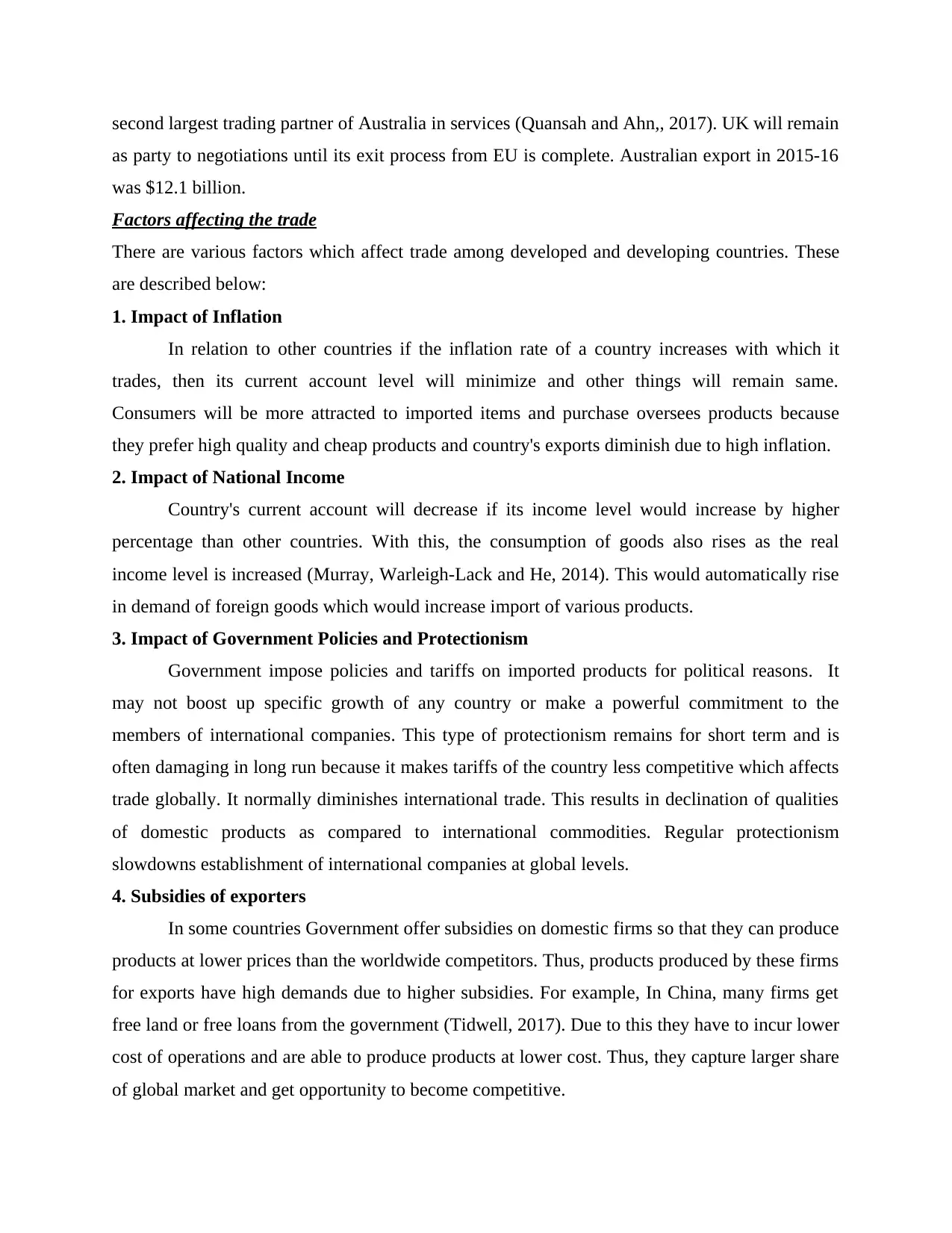
second largest trading partner of Australia in services (Quansah and Ahn,, 2017). UK will remain
as party to negotiations until its exit process from EU is complete. Australian export in 2015-16
was $12.1 billion.
Factors affecting the trade
There are various factors which affect trade among developed and developing countries. These
are described below:
1. Impact of Inflation
In relation to other countries if the inflation rate of a country increases with which it
trades, then its current account level will minimize and other things will remain same.
Consumers will be more attracted to imported items and purchase oversees products because
they prefer high quality and cheap products and country's exports diminish due to high inflation.
2. Impact of National Income
Country's current account will decrease if its income level would increase by higher
percentage than other countries. With this, the consumption of goods also rises as the real
income level is increased (Murray, Warleigh-Lack and He, 2014). This would automatically rise
in demand of foreign goods which would increase import of various products.
3. Impact of Government Policies and Protectionism
Government impose policies and tariffs on imported products for political reasons. It
may not boost up specific growth of any country or make a powerful commitment to the
members of international companies. This type of protectionism remains for short term and is
often damaging in long run because it makes tariffs of the country less competitive which affects
trade globally. It normally diminishes international trade. This results in declination of qualities
of domestic products as compared to international commodities. Regular protectionism
slowdowns establishment of international companies at global levels.
4. Subsidies of exporters
In some countries Government offer subsidies on domestic firms so that they can produce
products at lower prices than the worldwide competitors. Thus, products produced by these firms
for exports have high demands due to higher subsidies. For example, In China, many firms get
free land or free loans from the government (Tidwell, 2017). Due to this they have to incur lower
cost of operations and are able to produce products at lower cost. Thus, they capture larger share
of global market and get opportunity to become competitive.
as party to negotiations until its exit process from EU is complete. Australian export in 2015-16
was $12.1 billion.
Factors affecting the trade
There are various factors which affect trade among developed and developing countries. These
are described below:
1. Impact of Inflation
In relation to other countries if the inflation rate of a country increases with which it
trades, then its current account level will minimize and other things will remain same.
Consumers will be more attracted to imported items and purchase oversees products because
they prefer high quality and cheap products and country's exports diminish due to high inflation.
2. Impact of National Income
Country's current account will decrease if its income level would increase by higher
percentage than other countries. With this, the consumption of goods also rises as the real
income level is increased (Murray, Warleigh-Lack and He, 2014). This would automatically rise
in demand of foreign goods which would increase import of various products.
3. Impact of Government Policies and Protectionism
Government impose policies and tariffs on imported products for political reasons. It
may not boost up specific growth of any country or make a powerful commitment to the
members of international companies. This type of protectionism remains for short term and is
often damaging in long run because it makes tariffs of the country less competitive which affects
trade globally. It normally diminishes international trade. This results in declination of qualities
of domestic products as compared to international commodities. Regular protectionism
slowdowns establishment of international companies at global levels.
4. Subsidies of exporters
In some countries Government offer subsidies on domestic firms so that they can produce
products at lower prices than the worldwide competitors. Thus, products produced by these firms
for exports have high demands due to higher subsidies. For example, In China, many firms get
free land or free loans from the government (Tidwell, 2017). Due to this they have to incur lower
cost of operations and are able to produce products at lower cost. Thus, they capture larger share
of global market and get opportunity to become competitive.
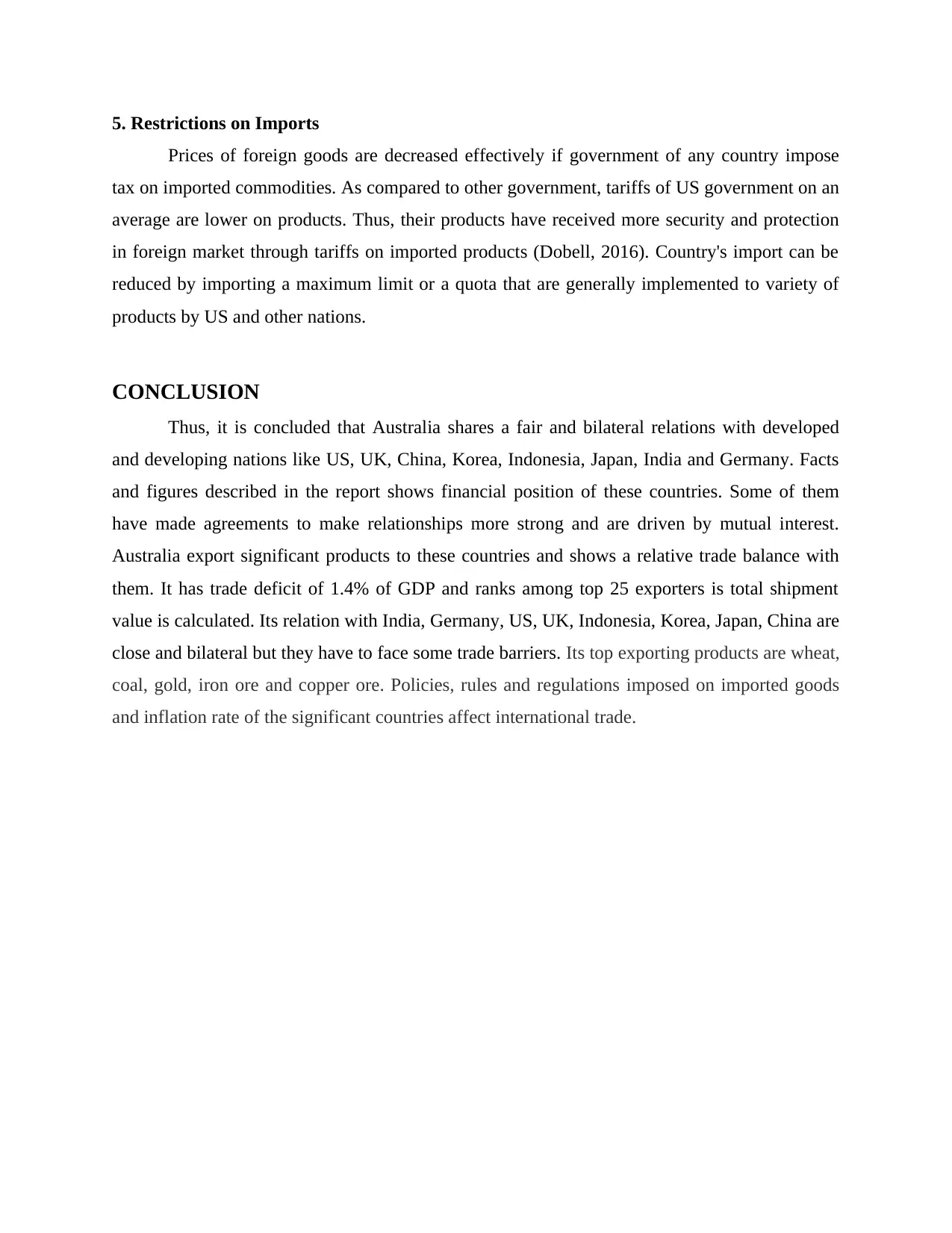
5. Restrictions on Imports
Prices of foreign goods are decreased effectively if government of any country impose
tax on imported commodities. As compared to other government, tariffs of US government on an
average are lower on products. Thus, their products have received more security and protection
in foreign market through tariffs on imported products (Dobell, 2016). Country's import can be
reduced by importing a maximum limit or a quota that are generally implemented to variety of
products by US and other nations.
CONCLUSION
Thus, it is concluded that Australia shares a fair and bilateral relations with developed
and developing nations like US, UK, China, Korea, Indonesia, Japan, India and Germany. Facts
and figures described in the report shows financial position of these countries. Some of them
have made agreements to make relationships more strong and are driven by mutual interest.
Australia export significant products to these countries and shows a relative trade balance with
them. It has trade deficit of 1.4% of GDP and ranks among top 25 exporters is total shipment
value is calculated. Its relation with India, Germany, US, UK, Indonesia, Korea, Japan, China are
close and bilateral but they have to face some trade barriers. Its top exporting products are wheat,
coal, gold, iron ore and copper ore. Policies, rules and regulations imposed on imported goods
and inflation rate of the significant countries affect international trade.
Prices of foreign goods are decreased effectively if government of any country impose
tax on imported commodities. As compared to other government, tariffs of US government on an
average are lower on products. Thus, their products have received more security and protection
in foreign market through tariffs on imported products (Dobell, 2016). Country's import can be
reduced by importing a maximum limit or a quota that are generally implemented to variety of
products by US and other nations.
CONCLUSION
Thus, it is concluded that Australia shares a fair and bilateral relations with developed
and developing nations like US, UK, China, Korea, Indonesia, Japan, India and Germany. Facts
and figures described in the report shows financial position of these countries. Some of them
have made agreements to make relationships more strong and are driven by mutual interest.
Australia export significant products to these countries and shows a relative trade balance with
them. It has trade deficit of 1.4% of GDP and ranks among top 25 exporters is total shipment
value is calculated. Its relation with India, Germany, US, UK, Indonesia, Korea, Japan, China are
close and bilateral but they have to face some trade barriers. Its top exporting products are wheat,
coal, gold, iron ore and copper ore. Policies, rules and regulations imposed on imported goods
and inflation rate of the significant countries affect international trade.
Secure Best Marks with AI Grader
Need help grading? Try our AI Grader for instant feedback on your assignments.
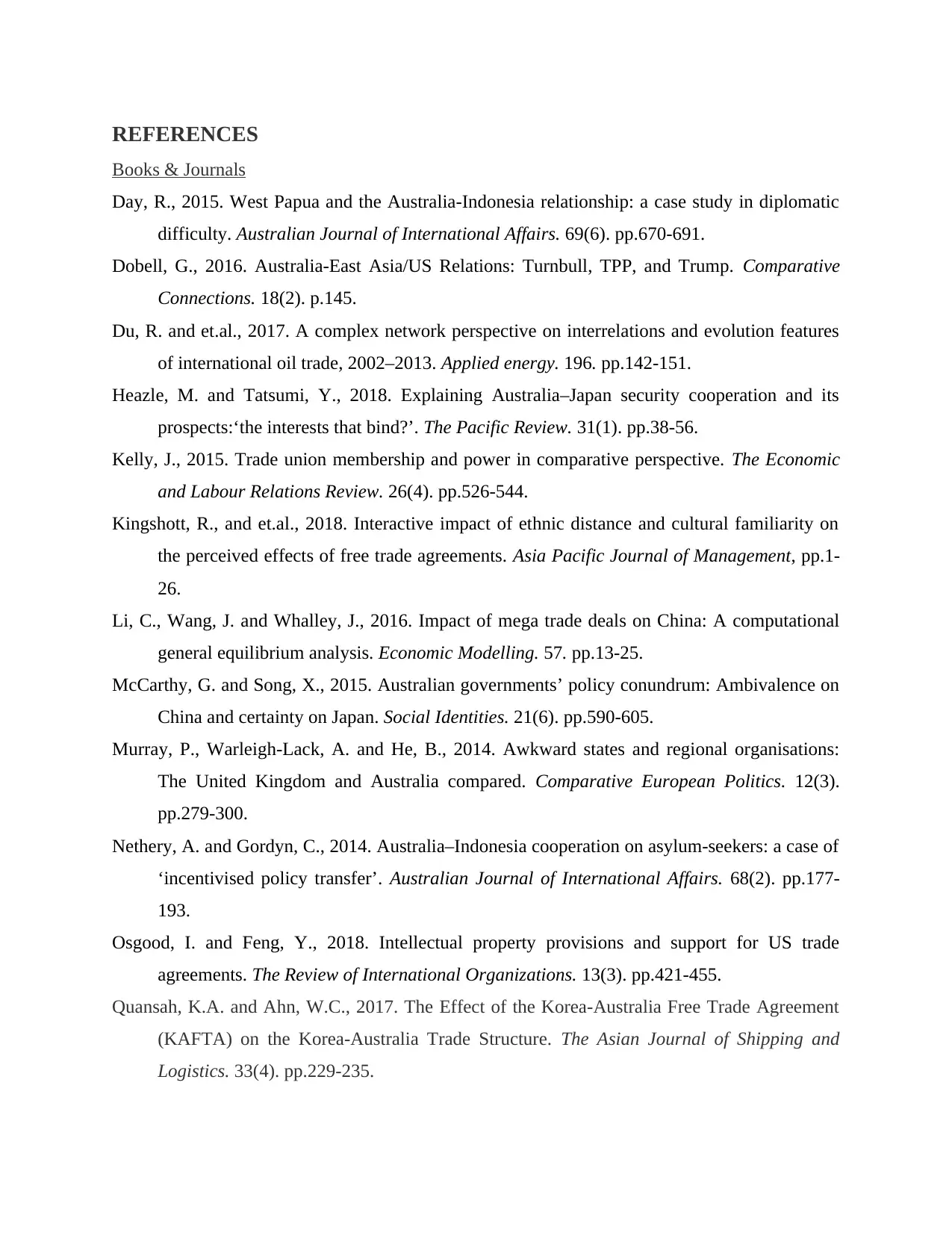
REFERENCES
Books & Journals
Day, R., 2015. West Papua and the Australia-Indonesia relationship: a case study in diplomatic
difficulty. Australian Journal of International Affairs. 69(6). pp.670-691.
Dobell, G., 2016. Australia-East Asia/US Relations: Turnbull, TPP, and Trump. Comparative
Connections. 18(2). p.145.
Du, R. and et.al., 2017. A complex network perspective on interrelations and evolution features
of international oil trade, 2002–2013. Applied energy. 196. pp.142-151.
Heazle, M. and Tatsumi, Y., 2018. Explaining Australia–Japan security cooperation and its
prospects:‘the interests that bind?’. The Pacific Review. 31(1). pp.38-56.
Kelly, J., 2015. Trade union membership and power in comparative perspective. The Economic
and Labour Relations Review. 26(4). pp.526-544.
Kingshott, R., and et.al., 2018. Interactive impact of ethnic distance and cultural familiarity on
the perceived effects of free trade agreements. Asia Pacific Journal of Management, pp.1-
26.
Li, C., Wang, J. and Whalley, J., 2016. Impact of mega trade deals on China: A computational
general equilibrium analysis. Economic Modelling. 57. pp.13-25.
McCarthy, G. and Song, X., 2015. Australian governments’ policy conundrum: Ambivalence on
China and certainty on Japan. Social Identities. 21(6). pp.590-605.
Murray, P., Warleigh-Lack, A. and He, B., 2014. Awkward states and regional organisations:
The United Kingdom and Australia compared. Comparative European Politics. 12(3).
pp.279-300.
Nethery, A. and Gordyn, C., 2014. Australia–Indonesia cooperation on asylum-seekers: a case of
‘incentivised policy transfer’. Australian Journal of International Affairs. 68(2). pp.177-
193.
Osgood, I. and Feng, Y., 2018. Intellectual property provisions and support for US trade
agreements. The Review of International Organizations. 13(3). pp.421-455.
Quansah, K.A. and Ahn, W.C., 2017. The Effect of the Korea-Australia Free Trade Agreement
(KAFTA) on the Korea-Australia Trade Structure. The Asian Journal of Shipping and
Logistics. 33(4). pp.229-235.
Books & Journals
Day, R., 2015. West Papua and the Australia-Indonesia relationship: a case study in diplomatic
difficulty. Australian Journal of International Affairs. 69(6). pp.670-691.
Dobell, G., 2016. Australia-East Asia/US Relations: Turnbull, TPP, and Trump. Comparative
Connections. 18(2). p.145.
Du, R. and et.al., 2017. A complex network perspective on interrelations and evolution features
of international oil trade, 2002–2013. Applied energy. 196. pp.142-151.
Heazle, M. and Tatsumi, Y., 2018. Explaining Australia–Japan security cooperation and its
prospects:‘the interests that bind?’. The Pacific Review. 31(1). pp.38-56.
Kelly, J., 2015. Trade union membership and power in comparative perspective. The Economic
and Labour Relations Review. 26(4). pp.526-544.
Kingshott, R., and et.al., 2018. Interactive impact of ethnic distance and cultural familiarity on
the perceived effects of free trade agreements. Asia Pacific Journal of Management, pp.1-
26.
Li, C., Wang, J. and Whalley, J., 2016. Impact of mega trade deals on China: A computational
general equilibrium analysis. Economic Modelling. 57. pp.13-25.
McCarthy, G. and Song, X., 2015. Australian governments’ policy conundrum: Ambivalence on
China and certainty on Japan. Social Identities. 21(6). pp.590-605.
Murray, P., Warleigh-Lack, A. and He, B., 2014. Awkward states and regional organisations:
The United Kingdom and Australia compared. Comparative European Politics. 12(3).
pp.279-300.
Nethery, A. and Gordyn, C., 2014. Australia–Indonesia cooperation on asylum-seekers: a case of
‘incentivised policy transfer’. Australian Journal of International Affairs. 68(2). pp.177-
193.
Osgood, I. and Feng, Y., 2018. Intellectual property provisions and support for US trade
agreements. The Review of International Organizations. 13(3). pp.421-455.
Quansah, K.A. and Ahn, W.C., 2017. The Effect of the Korea-Australia Free Trade Agreement
(KAFTA) on the Korea-Australia Trade Structure. The Asian Journal of Shipping and
Logistics. 33(4). pp.229-235.
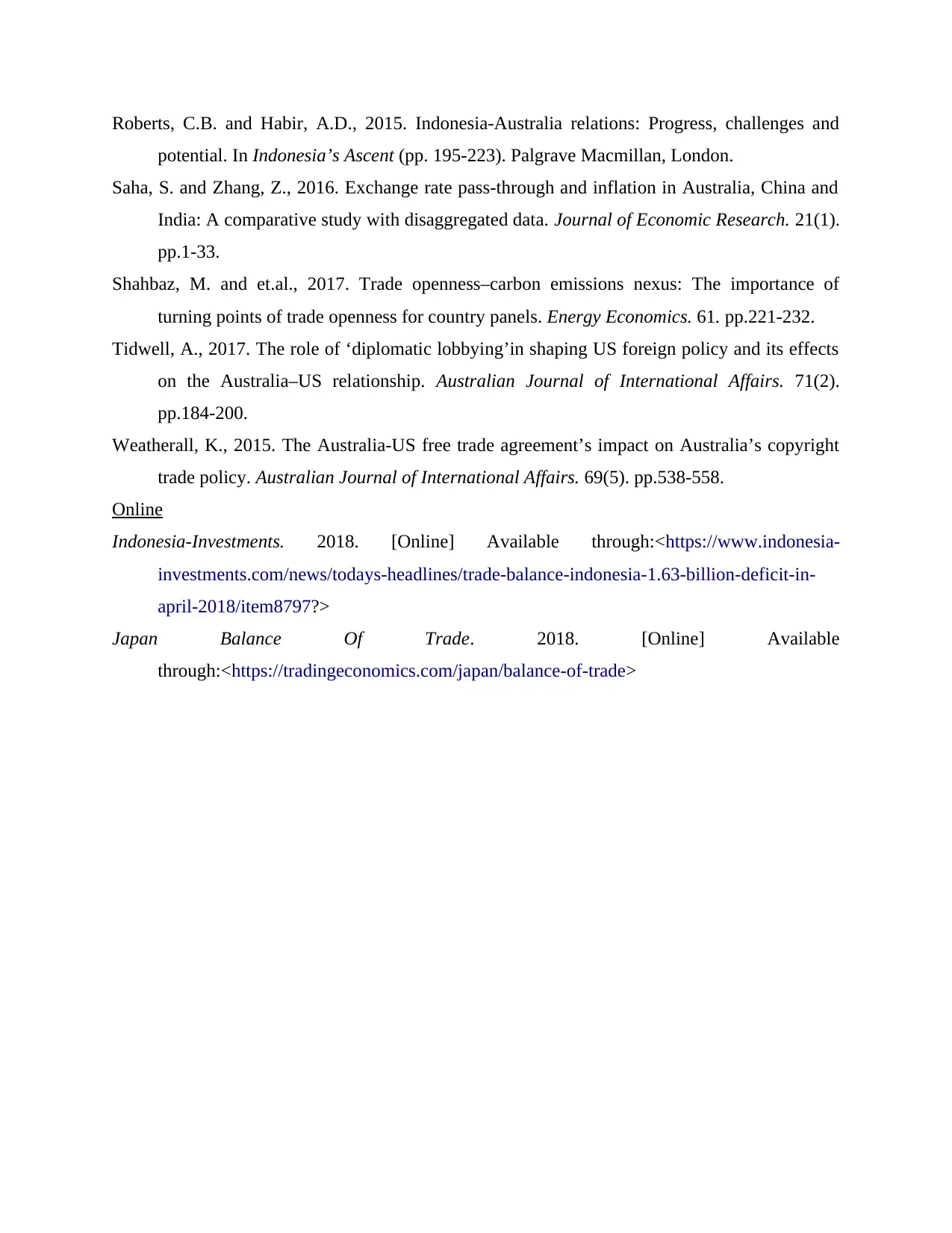
Roberts, C.B. and Habir, A.D., 2015. Indonesia-Australia relations: Progress, challenges and
potential. In Indonesia’s Ascent (pp. 195-223). Palgrave Macmillan, London.
Saha, S. and Zhang, Z., 2016. Exchange rate pass-through and inflation in Australia, China and
India: A comparative study with disaggregated data. Journal of Economic Research. 21(1).
pp.1-33.
Shahbaz, M. and et.al., 2017. Trade openness–carbon emissions nexus: The importance of
turning points of trade openness for country panels. Energy Economics. 61. pp.221-232.
Tidwell, A., 2017. The role of ‘diplomatic lobbying’in shaping US foreign policy and its effects
on the Australia–US relationship. Australian Journal of International Affairs. 71(2).
pp.184-200.
Weatherall, K., 2015. The Australia-US free trade agreement’s impact on Australia’s copyright
trade policy. Australian Journal of International Affairs. 69(5). pp.538-558.
Online
Indonesia-Investments. 2018. [Online] Available through:<https://www.indonesia-
investments.com/news/todays-headlines/trade-balance-indonesia-1.63-billion-deficit-in-
april-2018/item8797?>
Japan Balance Of Trade. 2018. [Online] Available
through:<https://tradingeconomics.com/japan/balance-of-trade>
potential. In Indonesia’s Ascent (pp. 195-223). Palgrave Macmillan, London.
Saha, S. and Zhang, Z., 2016. Exchange rate pass-through and inflation in Australia, China and
India: A comparative study with disaggregated data. Journal of Economic Research. 21(1).
pp.1-33.
Shahbaz, M. and et.al., 2017. Trade openness–carbon emissions nexus: The importance of
turning points of trade openness for country panels. Energy Economics. 61. pp.221-232.
Tidwell, A., 2017. The role of ‘diplomatic lobbying’in shaping US foreign policy and its effects
on the Australia–US relationship. Australian Journal of International Affairs. 71(2).
pp.184-200.
Weatherall, K., 2015. The Australia-US free trade agreement’s impact on Australia’s copyright
trade policy. Australian Journal of International Affairs. 69(5). pp.538-558.
Online
Indonesia-Investments. 2018. [Online] Available through:<https://www.indonesia-
investments.com/news/todays-headlines/trade-balance-indonesia-1.63-billion-deficit-in-
april-2018/item8797?>
Japan Balance Of Trade. 2018. [Online] Available
through:<https://tradingeconomics.com/japan/balance-of-trade>

Paraphrase This Document
Need a fresh take? Get an instant paraphrase of this document with our AI Paraphraser

1 out of 14
Related Documents
Your All-in-One AI-Powered Toolkit for Academic Success.
+13062052269
info@desklib.com
Available 24*7 on WhatsApp / Email
![[object Object]](/_next/static/media/star-bottom.7253800d.svg)
Unlock your academic potential
© 2024 | Zucol Services PVT LTD | All rights reserved.





